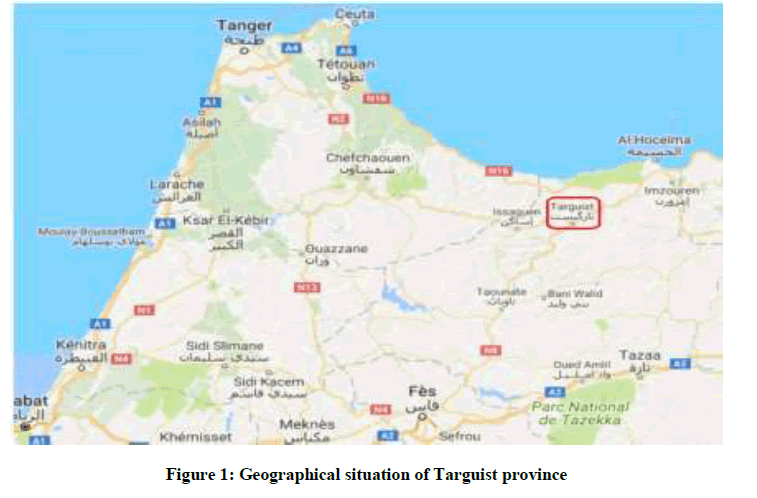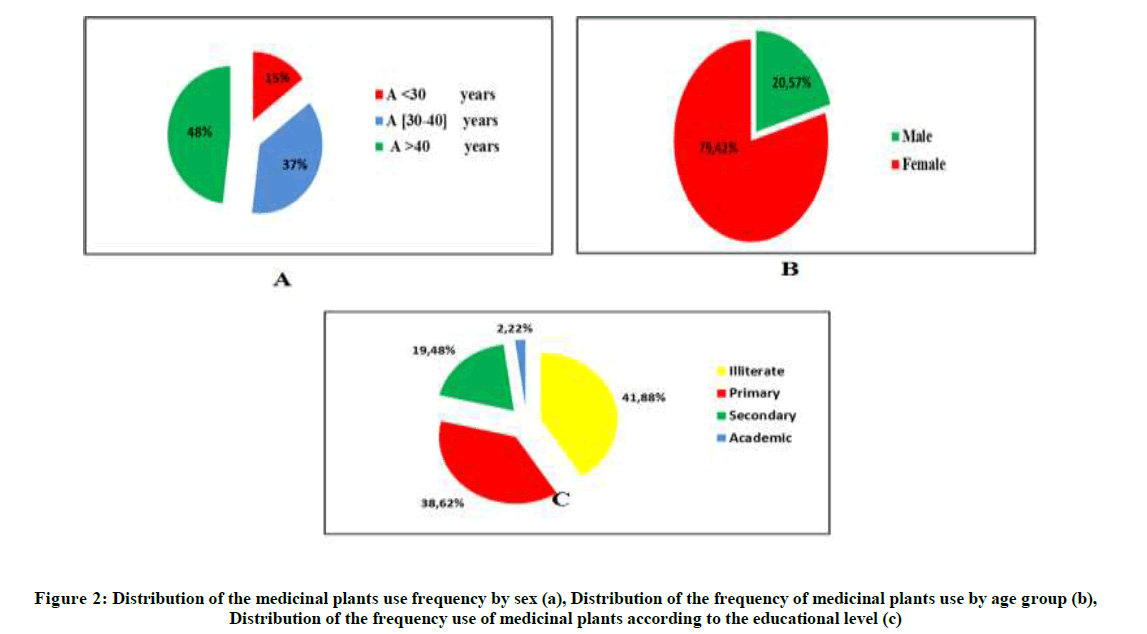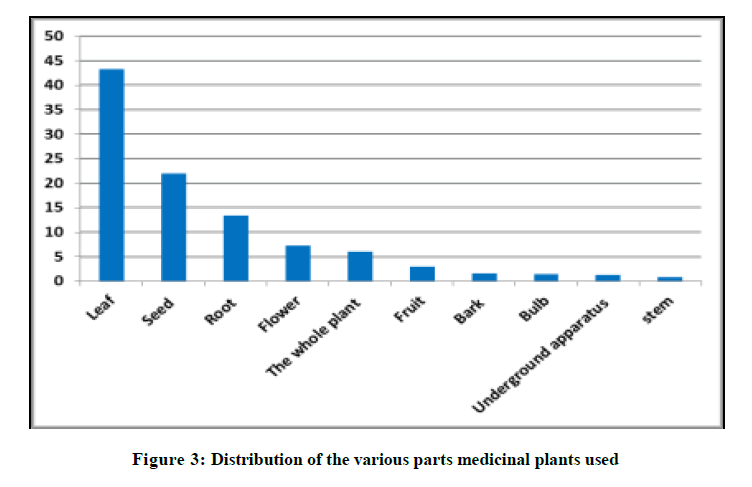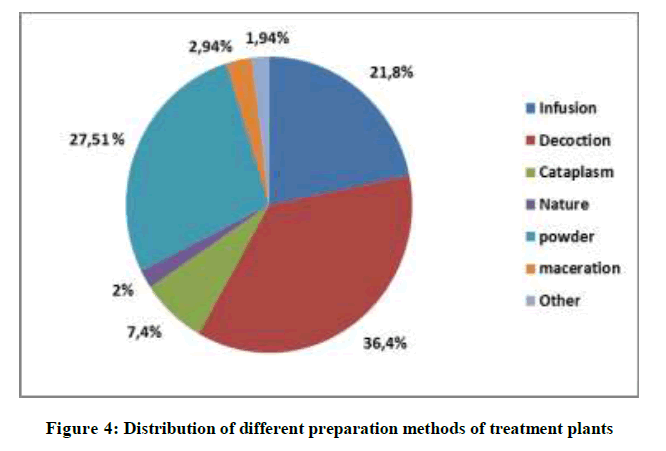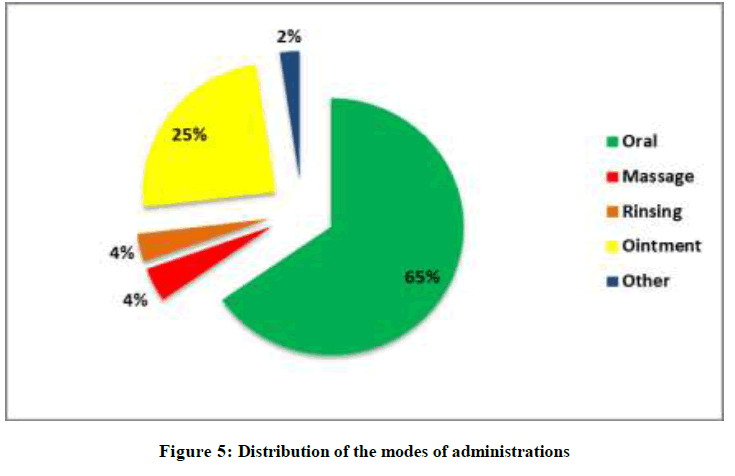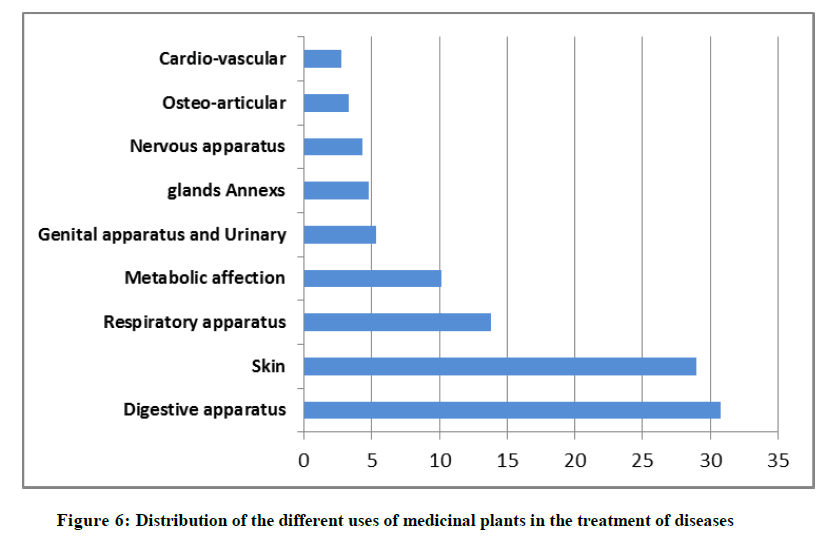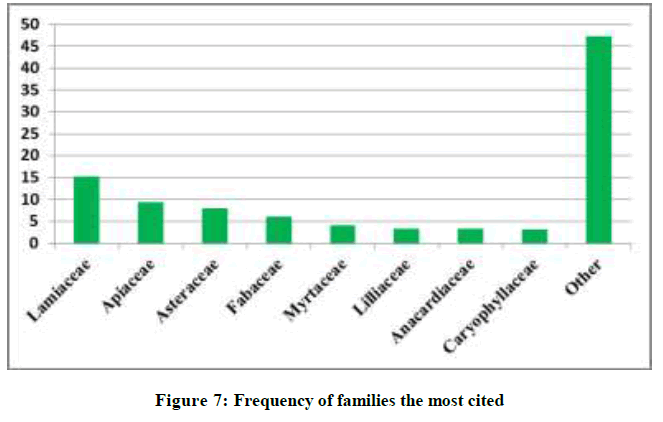Research Article - Der Pharma Chemica ( 2018) Volume 10, Issue 5
Ethnobotanical Survey of Medicinal and Aromatic Plants Used by the People of Targuist in the North of Morocco
Zouhri Aziz* and Aarab Lotfi
Laboratory of Bioactive Molecules (LMBSF), Faculty of Sciences & Techniques, University Sidi Mohamed Ben Abdellah, P.O. Box 2202, Road of Immouzer, Fez, Morocco
- *Corresponding Author:
- Zouhri Aziz
Laboratory of Bioactive Molecules (LMBSF)
Faculty of Sciences & Techniques
University Sidi Mohamed Ben Abdellah
P.O. Box 2202, Road of Immouzer, Fez, Morocco
Abstract
An ethnobotanical survey of plants has been carried out in Targuist area (North of Morocco), it aimed to collect information on the medical and cosmetic uses of plants. By using 3500 questionnaires, ethnobotanical survey was conducted during two periods (2016 and 2017), with traditional herbalists and users of these plants. The analysis of results identified 90 plants distributed in 43 families with a dominance of the lamiaceae (15.28%). The survey revealed that leaves were the most used part of the plants (43%) and the majority preparation used was a decoction (36.6%). Digestive diseases represent the most cited diseases (31%).
Keywords
Medicinal and aromatic plants, Ethnobotanical survey, Questionnaire, Targuist
Introduction
Medicinal plants still remain a source of medical care in the developing countries in the absence of a modern medical system [1]. Morocco is one of the Mediterranean countries which have a long medical tradition and a traditional know-how to basis of medicinal plants [2,3]. By its geographical situation, the Kingdom is a natural framework quite original that offers a full range of Mediterranean bioclimate that fosters a rich and varied flora. In effect, the Moroccan flora contains about 500 species and subspecies, potentially aromatics and/or medicinal, including a very reduced number operating on an industrial scale [2]. The ethnobotanical studies that have been carried out in Morocco show that regional data on medicinal plants are very fragmented and scattered [4-9]. Our study is part of the objective: to establish a catalog of the medicinal plants used by the population of Targuist city, collect the therapeutic applications, and local traditional plants.
Materials and Methods
Description of the study area
The City of Targuist derives its name from the Berber word "targist" which means "man standing." It is located in the Tangier-Tetouan-Al- Hoceima and Rif regions (Latitude: 34° 57' North; longitude: 4° 18' west; Altitude: 994 m). The province of Targuist is surrounded by the Mediterranean Sea to the north, the province of Taounate to the south, the province of Taza to the east and the province of Chefchaouen to the west (Figure 1). The total population of the province is estimated at 26,000 inhabitants with a high density of 2352.8 inhabitants/km2.
Method of the ethnobotanical study
The information on the use of medicinal plants are collected from the inhabitants of the city of Targuist during the year 2016-17. To meet the objectives of the study, a sheet questionnaire has been developed. It is based on open-ended and close-ended questions. The content of these fact sheets have been established in order to collect the maximum information on therapeutic uses of medicinal plants. This questionnaire contains two main parts: The first corresponding to the profile of the surveyed (Age, level of education, family situation) and the second devoted to plants (Vernacular names, pathologies treated, part used).
The taxonomic identification of the harvested species was later carried out in the laboratory of the Faculty of Science and Technology of Fez through a number of botanical works [5,10,11]. A total of 3,500 questionnaire sheets were developed; the data of the survey ethnobotanical obtained have been processed by the Excel software.
Results and Discussion
Profile of respondents
In the province of Targuist, both sexes are affected by traditional herbal medicines. However, women have a greater knowledge on the plant species and their use with a predominance of 79% against a percentage of 21% among men (Figure 2a). Most of the respondents are older than 40 years (48%), then come the age 30-40, and less than 30 years with respective percentages of 37% and 15% (Figure 2b). At the level of the study area, the majority of the respondents are illiterate (42%), followed by the categories of primary and secondary with percentages respectively 39% and 19%. Nevertheless, people with a university level education use little medicinal plants with a percentage of 2% (Figure 2c).
Parts of the plant used
In traditional medicine, different parts of plants identified particularly the leaves, flowers, seeds, roots, the fruit or even whole plant are exploited by the local population. In our study, the leaves are most used with a rate of 43.27%, followed by the seeds (21.94%), the roots (13.34%), the flowers (7.25%), the entire plant (6%) and the whole of the parts remaining used namely fruit, bark, bulbs, rhizomes and stems are represented by a cumulative rate of 8.13% (Figure 3).
This frequency of use raised of leaves, seeds and roots (78.55%) can be explained by the ease and the speed of the harvest [12-14]. But also by the fact that leaves are the seat of the photosynthesis and sometimes the storage of the secondary metabolites responsible for biological properties of the plant.
Modes of preparation
In order to facilitate the administration of the active principles of the plant, several modes of preparation are employed to know the decoction, the infusion, the powder, fumigation, cataplasm, and the maceration. In the region of Targuist, the decoction remains the most dominant mode of preparation (36.4%), followed by the powder preparation and infusion respectively by 27.51% and 21.8%. The percentage of the other modes of preparation grouped (Cataplasm, maceration, cru) does not exceed 8% (Figure 4).
Mode of the administrations
According to Figure 5, most of the prepared recipes are orally prescribed with a large percentage of 65% followed by the ointment with a percentage of 25%, the rinsing and the massage with a 4% percentage, and the others mode of administration (2%) are little used by the local population.
Type of diseases treated
The ethnobotanical survey conducted in the Targuist region has identified a number of pathologies treated by medicinal plants. The results shown in Figure 6 show that the majority of medicinal plants are the main intervention in the treatment of diseases of the digestive system with a percentage of 31%, followed by dermatological diseases (29%), respiratory diseases (14%) and metabolic diseases (10%). These same results were found by Tahri et al. [15] in the province of Settat, by Salhi et al. [16] in the city of Kenitra and Daoudi et al. [17] in the province of Khénifra. The rest of the diseases (Genitourinary, glands annexes, neurological, ostéoarticular glands and cardiovascular) represent less than 6%, which suggests that the local population are not affected by these last disorders.
Floristic analysis
According to the families
The medicinal species identified in the study area are of 90 species distributed in 43 families. The analysis of these results (Figure 7) shows that the Lamiaceae family occupies the first ranks with a percentage 15.28%, Apiaceae (9.31%), Asteraceae (8%), Fabaceae (6.14%), Poaceae (6.12%), Myrtaceae (4.17%) and Liliaceae and anacardiaceae and caryophyllaceae with the same percentage (3%). The rest of families are represented by 47.28%. The result is in accordance with that obtained by Bouayyadi et al. [18] in the region of the west of Morocco and Benlamdini [19] in oriental High Atlas of Morocco.
According to the most used medicinal plants
On the totality of the results obtained, we gathered the most used species in traditional herbal medicine by the local population. Most of the species (Table 1) grow spontaneously or are grown in the study area.
| Family | Scientific name of the species | Vernacular name | Number of citation |
|---|---|---|---|
| Thymus | Thymus vulgaris | Zaatar | 192 |
| Lamiaceae | Mentha pulegium | Fluo | 185 |
| Cannabaceae | Cannabis sativa | Lkif | 106 |
| Lamiaceae | Rosmarinus officinalis | Azir | 99 |
| Asparagaceae | Leopoldia comosa | Zaz | 90 |
| Myrtaceae | Eugenia caryophyllata | Kranfal | 81 |
| Cupressaceae | Juniperus foetidissima | Laraar | 76 |
| Lamiaceae | Ocimum basilium L, | Rihane | 69 |
| Ranunculaceae | Nigella sativa | lhaba souda | 69 |
| Lamiaceae | Salvia officinalis | salmia (kasaine) | 65 |
| Fabaceae | Trigonella foenum-graecum | Helba | 62 |
| Poaceae | Pennisetum glaucum | ilane (dakhne) | 61 |
| Caryophyllaceae | Herniaria hirsuta | haras lahjar | 61 |
| Pinaceae | Pinus halepensis Mill, | Tayda | 58 |
| Anacardiaceae | Pistacia lentiscus | Drou | 58 |
| Amaranthaceae | Chenopodium ambrosioides | Mkhinza | 56 |
| Lamiaceae | Lavandula stoechas | Halhal | 56 |
| Anacardiaceae | Pistacia atlantica | Btem | 56 |
| Asteraceae | Inula viscasa Ait, | Bagarman | 51 |
| Asteraceae | Atractylis gummifera L, | Togham | 50 |
Table 1: The first 20 medicinal species used the most in the region of Targuist
Conclusion
The ethnobotanical study conducted in the province of Targuist made it possible to inventory the medicinal plants used in the specific traditional medicine of this region. Indeed, the results of this study shows that the local population still prefer to use natural species to address their daily ills. The Information acquired from the questionnaire forms helped us to compile a catalog of 90 plant species whose monographs of medicinal plants are represented in this article.
These taxa is distributed in 43 families with a clear dominance of the Lamiaceae family. In addition, the analysis of the results obtained show that the leaves are the most used part with a percentage of 43%. The decoction (36%) is the most popular method of preparation in most recipes and oral mode (65%). These medicinal plants are used mainly for the treatment of diseases of the digestive system (31%), dermatological diseases (29%), and respiratory diseases (14%). Finally, phytochemical, pharmacological and toxicological studies on these plants must be carried out for the purpose of scientific validation of the traditional uses of these plants and to make the traditional medicines Bios.
References
- S. Tabuti, A. Lye, S. Dhillion, J. Ethnopharmacol.,2003, 88, 19-44.
- A.M. Scherer, R. Motti, C.S. Weckeerie, J. Ethnopharmacol.,2005, 97, 129-143.
- B. Bourkhiss, M. Ouhssine, M. Hnach, 2nd International Symposium on Aromatic and Medicinal Plants, Marrakech,2006.
- A. Zouhri, A. Bousfiha, L. Aarab, Phytother.,2017, 15(2), 67-71.
- J. Bellakhdar, Editions Le Fennec, (Ed.) (Eds.), Ibis Press, Casablanca, Maroc, 1997, 764.
- A. Kahouadji, PhD Thesis, Montpellier, 1986.
- S. Hseini, A. Kahouadji, H. Lahsissène, Lazaroa., 2011, 28:93-100.
- R. Mehdioui, A. Kahouadji, Bull. Inst. Scient. Rabat.,2007, n°29, 11-20.
- S. Salhi, M. Fadli, L. Zidane, A. Douira, Lazaroa.,2010, 31: 133-46.
- M. Fennane, M. Ibn Tattou, J. Mathez, A. Ouyahya, J. El Oualidi, Série Botanique-Institut Scientifique de Rabat.,1999,558-636.
- E. Bayer, K.P. Buttler, X. Finkenzeller, Editions Delachaux and Niestlé, Italian, 1990, 287.
- M. Bitsindou, Doctoral thesis, Free University of Brussels,1986, 482.
- M. Ghourri, L. Zidane, A. Rochdi, Kastamonu University J. Forestry Faculty.,2012, 12(2), 218-235.
- M. Fadil, A. Farah, T. Haloui, Phytother.,2015, 13(1), 19-30.
- N. Tahri, A. Elbasti, L. Zidane, A. Rochdi, A. Douira, J. Fac. For. Istanbul U., 2012,12(2), 192-208.
- S. Salhi, M. Fadli, L. Zidane, A. Douira, Lazaroa.,2010,31, 133-146.
- A. Daoudi, M. Bammou, S. Zarkani, Phytothérapie, 2016, 14(4), 220-228.
- L. Bouayyadi, M. El Hafian, L. Zidane, J. Appl. Biosci.,2015, 93, 8770-8788.
- M. El Hafian, M. Benlamdini, H. Elyacoubi, L. Zidane, A. Rochdi, J. Appl. Biosci.,2014, 78(1), 6771-6787.
ANNEXE 1: Ethnobotanical survey sheet
Informant
- Age: A1 (< 30); A2 (30-40); A3 (> 40)
- Sex: Male & Female
- Level of study: Illiterate; Primary; Secondary; Academic
- Family situation: Married & Single
Vegetal material
| Medicinal species | Type of disease | Preparation Mode | Used Part | Dose utilise | Sale price |
|---|---|---|---|---|---|
Used Part: Stem; Flower; Fruit; Seed; Bark; Underground apparatus; Bulb; Leaf; The whole plant
Instructions of usage: Infusion; Decoction; Cataplasm; Nature; Powder; Maceration; Other.,
Administration mode: Oral; Massage; Rinsing; Ointment; Other,
Side effects: --------
Toxicity: ---------
ANNEXE 2
Supplementary Table: Aromatic and medicinal plants used in traditional medicine by the Targuist population
| Family | Scientific name of the specie | Vernacular name | Number of | Part used | Preparation | administration | Medicinal use |
|---|---|---|---|---|---|---|---|
| citation | |||||||
| Anacardiaceae | Pistacia atlantica | Btem | 56 | Leaves and Bark | Decoction | Oral | Against stomach pains |
| Pistacia lentiscus | Drou | 58 | leaves and Bark | Decoction and Powder | Oral | Anti-diarrheal and diabetes | |
| Rhus pentaphylla | Tizgha | 38 | Leaves | Cataplasm | Ointment | Against injury | |
| Asteraceae | Artemisia herba-alba | Chih | 4 | Leaves | Decoction | Oral | Intestinal worms, cold, stomach pains |
| Artemisia absinthium | Chiba | 4 | Leaves | Infusion | Oral | Diabetes, stomach pains | |
| Scolymus hispanicus | Garnina | 2 | Roots | Decoction | Oral | Diabetes | |
| Lactuca sativa | Elkhasse | 5 | Leaves | Cataplasm | Oral | Headache | |
| Atractylis gummifera L, | Togham | 50 | Roots | Powder | Ointment and Oral | Inhibits bleeding and vomiting | |
| Inula viscosa Ait, | Bagarman | 51 | Leaves | Cataplasm | Ointment | Wound healing | |
| Bellis sylvestris | Hellala | 49 | Leaves | Infusion | Oral | Intestinal pains | |
| Calendula arvensis | Jamra | 32 | Flower | Cataplasm | Ointement | Anti-inflammatory and antiseptic | |
| Apiaceae | Cuminum cyminum L, | Bouchnikha | 26 | Seeds | Decoction | Oral | Toothache |
| Daucus carota | Khizou | 3 | Roots | Nature | Oral | Anti-diarrheal | |
| Carum carvi | karwiya | 48 | Seeds | Infusion | Oral | Facilitates digestion | |
| Petroselinum sativum | Maadnous | 2 | Roots | Powder | Ointment | Antirheumatismal | |
| Ammodaucus leucotrichus Coss. | Camoun soufi | 37 | Seeds | Powder and Infusion | Oral | Anti-diarrheal, Dermatological disease and osteoarticular | |
| Foeniculum vulgare | Nafaa | 49 | Seeds | Decoction | Oral | The painful rules | |
| Pinpinella anisum | Yansoune | 47 | Seeds | Infusion | Oral | Genitourinary diseases, anti-lice | |
| Conium maculatum L. | Ziyata | 3 | Leaves | Decoction | Oral | Female infertility | |
| Apium graveolens L, | krafass | 18 | Leaves | Decoction | Oral | kidney pain | |
| Petroselium crispum | Maadnous | 14 | Flower | Infusion | Oral | Neurological diseases | |
| Lamiaceae | Lavandula stoechas | Halhal | 56 | Leaves | Decoction | Oral | Against the flu |
| Lavandula angustifolia | khzama | 47 | Flower | Decoction | Oral | Asthma | |
| Ocimum basilicum L, | Lahbaq | 22 | Leaves | Cataplasm | Ointment | Fever | |
| Lavandula multifida L, | Kohayla | 32 | Leaves | Powder | Oral | Lung disorders | |
| Mentha suaveolens | Marseta | 12 | Leaves | Decoction | Oral | Vertigo | |
| Mentha pulegium | Fluo | 185 | Leaves | Infusion | Oral | Respiratory disease | |
| Teucrium fruticans | Miou | 24 | Leaves | Decoction | Oral | Cold | |
| Salvia officinalis | Salmia | 65 | Leaves | Infusion | Oral | Digestive system diseases | |
| Origanum majorana | Mardadouche | 19 | Leaves | Essential oils | Oral | Respiratory disease | |
| Rosmarinus officinalis | Azir | 99 | Leaves | Infusion | Oral | Respiratory disease | |
| Ocimum basilium L, | Rihane | 69 | Leaves | Infusion | Oral | Digestive system diseases | |
| Fabaceae | Trigonella foenum-graecum | Helba | 62 | Seeds | Powder | Oral | Against weight loss, stomach pain, osteoarticular |
| Glycyrrhiza glabra L, | Arq sousse | 12 | Roots | Powder | Oral | Cough, stomach pain | |
| Vicia faba L, | Lfoul | 3 | Fruit | Powder | Oral | Gastric acidity | |
| Cicer arietinum L | Lhamss | 11 | Seeds | Powder | Oral | Renal lithiasis | |
| Ceratonia siliqua | Kharoub | 16 | Fruit | Powder | Oral | digestive system diseases | |
| Phaseolus vulgaris | loubya | 26 | Seeds | Powder | Ointment | Eczema | |
| Cassia fistula | Khyar chambar | 12 | Fruit | Powder | Oral | Joint pain | |
| Lilliaceae | Asphodelus microcarpus salzm | Barwag | 28 | Roots | Cataplasm | Ointment | Dermatological disease |
| Urginea maritima | Bassla dib | 31 | Roots | Decoction | Oral | Digestive system diseases | |
| Asparagus officinalis L, | Sakom | 40 | underground apparatus | Decoction | Oral | Diuretic | |
| Poaceae | Hordeum vulgare L, | Chaair | 4 | Seeds | Powder | Oral | Antidiarrheal |
| Zea mays | Dra | 18 | Seeds | Decoction | Oral | Anti-inflammatory, antidiabetes | |
| Pennisetum glaucum | Ilane (dakhne) | 61 | Seeds | Powder | Oral | Joint pain | |
| Malvaceae | Hibiscus sabdariffa | Karkadi | 47 | Flower | Infusion | Oral | Respiratory disease, Hair strengthening |
| Malva sylvestris | Khobbeza | 3 | Leaves | Cataplasm | Ointment | Anti-inflammatory | |
| Myrtaceae | Eucalyptus globulus | Kalibtus | 46 | Leaves | Decoction | Oral | stomach pains and urinary affection |
| Myrtus communis | Rayhan | 29 | Leaves | Powder | Oral and Ointment | Stomach pains, hair strengthening | |
| Eugenia caryophyllata | Kranfal | 81 | Flower | Powder | Massage | Joint pain | |
| Ericaceae | Arbutus unedo | Bakhanou | 7 | Roots | Decoction | Oral | Digestive system diseases |
| Arecaceae | Chamaerops humilis | Doum | 40 | Fruit | Decoction | Oral | Anti-diarrheal |
| Iridaceae | Crocus sativus | Zaafrane lhor | 11 | Leaves | Powder | Ointment | Eczema |
| Gladiolus italicus | Sif-dib | 34 | Roots | Infusion | Oral | Stomach pain | |
| Caryophyllaceae | Herniaria hirsuta | Haras lahjar | 61 | Leaves | Powder | Oral | Genitourinary diseases |
| Saponaria officinalis L, | Saponia | 47 | Leaves et Roots | Cataplasm | Ointment | Eczema | |
| Cucurbitaceae | Citrullus colocynthis L, | Lahdaj | 25 | Seeds | Powder | Oral and Ointment | Relaxing the stomach, eczema |
| Bryonia dioica | Ineb dib | 38 | Roots | Decoction | Oral | Anti-diarrheal | |
| Thymelaeaceae | Thymelaea hirsuta | Matmane | 50 | Flower | Powder | Rinsing | Hair strengthening |
| Daphne gnidium | Lazaz | 38 | Leaves | Powder | Rinsing | Hair strengthening | |
| Ranunculaceae | Ranunculus bulbosus | Sanat lfar | 15 | Leaves | Powder | Ointment | Skin disease |
| Nigella sativa | Lhaba souda | 69 | Seeds | Essential oils | Oral and Rinsing | Respiratory disease, hair strengthening | |
| Zingiberaceae | Elettaria cardamomum | Lhil | 42 | Leaves | Maceration | Oral | Digestive system diseases, cold |
| Fagaceae | Quercus rotundifolia | Karouch | 28 | Roots | Decoction | Oral | Fever |
| Quercus petraea | Balout | 11 | Flower | Cataplasm | Massage | Cardiovascular diseases | |
| Apocynaceae | Caralluma europaea cuss | Daghmouss | 46 | Leaves | Decoction | Oral | Cough, asthma |
| Cactaceae | Opuntia ficus-indica | Dalahia (hendiya) | 21 | Leaves et Roots | Decoction | Oral | kidney stones, anti-inflammatory |
| Amaranthaceae | Chenopodium ambrosioides | Mkhinza | 56 | Leaves | Decoction | Oral | gastrointestinal diseases, fever |
| Polygonaceae | Rumex acetosa | Hommayda | 4 | Leaves | Decoction | Oral | Digestive system diseases |
| Punicaceae | Punica granatum L, | Romane | 7 | Fruit | Decoction | Oral | Digestive system diseases |
| Rhamnaceae | Zyziphus lotus | Nbeg | 11 | Fruit | Nature | Oral | Digestive system diseases |
| Rosaceae | Prunus amygdalus | Louz | 5 | Seeds | Cataplasm | Ointment | Hair strengthening |
| Capparaceae | Capparis spinosa L, | Kabbar | 46 | Seeds | Powder | Oral | Cough |
| Solanaceae | Datura stramonium L, | Chdak jmal | 37 | Leaves | Cataplasm | Ointment | Anti-inflammatory |
| Aristolochiaceae | Aristolochia longa L, | Berztam | 32 | Roots | Powder | Ointment | Skin disease |
| Gentianaceae | Centaurium erythraea | Gosset lhaya | 45 | Flower | Powder | Ointment | Wound healing |
| Convolvulaceae | Convolvulus althaeoides L, | Lawaya | 29 | Leaves | Infusion | Oral | Constipation |
| Boraginaceae | Echium plantagineum L, | Lawcham | 27 | Leaves | Decoction | Oral | Diuretic |
| Papaveraceae | Papaver rhoeas L, | Balaaman | 42 | Flower | Infusion | Oral | Cough |
| Pinaceae | Pinus halepensis Mill, | Tayda | 58 | Leaves | Cataplasm | Ointment | Toothache |
| Plantaginaceae | Plantago coronopus L, | Rjal laghrab | 32 | Leaves | Cataplasm | Ointment | Anti-inflammatory |
| Thymus | Thymus vulgaris | Zaatar | 192 | Leaves | Infusion | Oral | Digestive system diseases |
| Cannabaceae | Cannabis sativa | Lkif | 106 | Seeds | Powder | Rinsing | Hair strengthening |
| Euphorbiaceae | Ricinus communis | Lkharouaa | 47 | Seeds | Essential oils | Rinsing | Dermatological disease, hair strengthening |
| Lauraceae | Laurus nobilis | Rand | 20 | Leaves | Decoction | Oral | Digestive system diseases |
| Asparagaceae | Leopoldia comosa | Zaz | 90 | Leaves | Powder | Rinsing | Hair strengthening |
| Cupressaceae | Juniperus foetidissima | Laraar | 76 | Bulb | Powder | Oral | Metabolic diseases |
| Valerianaceae | Valeriana officinalis | Nardine | 27 | Leaves | Powder | Oral | Neurological diseases, hair strengthening |
| Brassicaceae | Lepidum sativum | Hab rchad | 51 | Seeds | Decoction | Oral | Respiratory disease |
| Paeoniaceae | Paeonia officinalis | Oud salib | 46 | Seeds | Essential oils | Oral | Neurological diseases |

